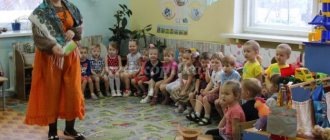Summary of GCD for children in the middle group. History of children's toys
Summary of the direct educational activities of children in the middle group
Abstract of children's educational activities in the middle group "History of children's toys"
Description of the material: Dear colleagues! I bring to your attention a summary of direct educational activities for children of the middle group (4-5 years old) on the topic “History of children's toys.” This summary will be useful to teachers of the middle group. This is a summary of an educational lesson aimed at fostering interest in the history of toys and respect for Russian traditions and customs. Integration of educational areas: social-communicative, cognitive, speech, artistic-aesthetic, physical development. Type of activity: visual, motor, cognitive-research, gaming, communicative. Age group: middle Topic: “History of children's toys” Purpose: introducing children to the history of toys Objectives: - development of communication and interaction of the child with adults and peers, formation of positive attitudes towards various types of work and creativity (social and communicative); — development of children’s interests, their curiosity and cognitive motivation; development of imagination and creative activity (cognitive); — enrichment of the active dictionary; development of coherent, grammatically correct dialogical and monologue speech (speech); — implementation of independent creative activity of children; the formation of an aesthetic attitude towards the surrounding world (artistic and aesthetic); - mastering outdoor games with rules; formation of focus and self-regulation in the motor sphere (physical). Preliminary work: 1. Joint visit to the Puppet Theater with parents; 2. Exhibition “Do-it-yourself toys”; 3. Repetition of previously learned poems by A. Borto from the “Toys” series; 4. Examination of plot pictures and composing a story based on them; 5. Watching the cartoon “Living Toy”; 6. Conversation about favorite toys; 7. Learning physical education Means of implementation: photo and video materials with toys from different eras; audio recordings from children's cartoons about toys; individual modeling kits (board, stack, plasticine, napkin); Gena's bi-ba-bo crocodile toy; children's favorite toys. GCD procedure: Children sit on soft cushions on the floor in a semicircle. To the music “Let them run clumsily...” from the cartoon “Cheburashka and the Crocodile Gena,” the teacher brings in the bi-ba-bo toy “Crocodile Gena” with a bag and conducts a dialogue with the children on behalf of the toy. He greets the children and pays attention to how many toys there are in the kindergarten. Addressing the children, he asks them to name and show them their favorite toy, describe it and tell them why he likes it. Listens carefully to the children's answers and invites them to listen to a story about the toys of their childhood. He takes out photographs of toys from those years from his bag, shows them and tells the children about them. He clarifies that previously toys in stores were very expensive and not everyone could afford them, so parents made toys for their children themselves. They were made of wood, straw, cloth, animal bone, feathers, clay, etc. This material is environmentally friendly and does not cause harm to health.
The teacher invites Gene and the children to watch a video using multimedia, which shows the manufacturing process and a story about the first straw toy “Bereginya”. He clarifies that this toy was not only an object of play for the child, but was also his amulet, protecting him from evil spirits.
Next, the teacher suggests comparing modern toys with toys of those years. Find similarities and differences in material, colors, sizes, properties, etc. It should be noted that modern toys have more capabilities: they move, make sounds, react to the approach of a child, etc.
The teacher tells the children and Gena the crocodile that, despite the fact that modern toys are very different from their predecessors, there is one type of toy that has always fascinated children. These are wind-up toys. Gena says that he has just such a toy with him. Shows the children a wind-up monkey. The teacher tells the students that they need to rest a little and, together with the crocodile Gena, conducts a physical lesson “Wind-up toys”: Look, in the store, all the toys on display: (Spread your arms wide to the sides) Wind-up bunnies, Dolls and balls, Fluffy kittens, (Turns to the right -to the left with outstretched arms) Matryoshka dolls, bear cubs - Everyone is sitting on the shelves (Sit down) They want to play with us. (Jumping). Crocodile Gena turns his attention to the clock and says that he has to go, Cheburashka is waiting for him. This is a very good toy and a good friend. He asks the children if they have a Cheburashka toy. Receiving negative answers, Gena invites the children to make their own toy from plasticine. The children happily support Gena’s proposal and say goodbye to him. The teacher shows on the interactive board the stages of sculpting Cheburashka, noting its characteristic features (big ears, triangular nose). After watching, the children begin to work to the musical accompaniment of the cartoon “Crocodile Gena and Cheburashka.” Result of the GCD A follow-up conversation is held: What new did the children learn about toys? What do they particularly remember? At the end of the work, a mini-exhibition with children's works is organized. Group photo for memory. Thank you for your attention!
We recommend watching:
Synopsis of an integrated GCD in kindergarten in the middle group Synopsis of GCD in the middle group on the theme “New Year” Synopsis of a lesson on applications in the middle group of kindergarten. Flowers Summary of GCD for FEMP in the middle group
Similar articles:
Lesson in the middle group “Winter clothes”
Project on the theme of the week “World of Fashion” in the middle group
Taimyr municipal budgetary preschool educational institution "Dudinsky Child Development Center - Kindergarten "Snow White", Dudinka city
Project on the theme of the week “World of Fashion”
In the middle group "Daisies"
Educator:
Kovalchuk N.V.
Objective of the project:
Expand and concretize children’s ideas about clothing
,
its purpose, and the details of which it consists.
Project objectives:
To form children’s ideas about clothing, its types, parts of clothing.
Develop children's speech and expand their vocabulary.
Develop color perception, figurative ideas, creativity, imagination, compositional skills, color perception.
Teach children to generalize, classify, systematize.
Teach children to take care of their clothes and develop a caring attitude towards them.
Project type:
group
Project type:
Creative, short-term, collective.
Duration:
short-term, 1 week (09.11-13.11)
Project participants:
children of the secondary group "Romashki", teachers, parents
Final event:
Role-playing game "Clothing Store"
Working with parents:
moving folders, information stand, three question method.
Project implementation stages:
Stage 1.
Selecting a project topic.
Thematic plan for the 2019-2020 academic year.
Selection of methodological literature on the topic of the week.
Selection of material, games - experiments, didactic games.
| Creativity Center Plasticine, crayons, paints, foam rubber, sticks, pictures, stencils, glue, templates, scraps of fabric | Book Center books by B. Grimm, N. Nosov. pictures on the topic of the week. | Experimentation Center Waste material, watering can, containers of various sizes, cups, molds, scraps of various fabrics |
| Construction Center constructor, cubes, mosaic, lego | Subject: "Fashion world" | Game center Attributes for s.zhetno role. games “Clothing Store”, “Family” |
| Cognition Center (board, exhibition) pictures on the theme of the week, fabric scraps | Theater Center Bibabo, house, finger. Theater, screen. | Center of movement Sport. equipment, massage mats, modules, engines, ribbons, flags, steering wheels. |
- by type of children's activity:
| Gaming We play board and printed games “Find a pair”, “Dress the doll”, “Find an object”, “Who is wearing what” puzzles, plot-role-playing games using attributes, | Artistic Reading fairy tales and stories by B. Grimm, N. Nosov | Communicative speech games, looking at pictures |
| Motor Fun games, p/i, games to develop dexterity, eye | Subject: "Fashion world" | Labor We clean the corner of nature, the group, wash the toys, water the flowers, put the toys in their places. |
| Cognitive and research We look at pictures and experiments with fabrics | Productive sculpt, draw, design | Musical Imitation of various sounds, playing musical instruments |
Summary of a lesson on speech development in the middle group “My favorite toys”
Summary of a lesson on speech development in the middle group
"My favorite toys"
Target:
Develop speech by writing descriptive stories using graphic diagrams.
Tasks:
Educational:
Teach children to write a descriptive, coherent and consistent story about toys using a diagram.
Strengthen the ability to examine an object from perceiving it as a whole to identifying essential features.
In the description - define the object, consistently describe the parts, properties (color, shape, size, qualities, actions with it, and at the end express a value judgment.
Use in speech the names of objects, their parts, details, materials from which they are made.
Developmental tasks:
Strengthen correct pronunciation skills
Develop phonemic awareness and sound analysis skills
Develop grammatical structure of speech.
Educational tasks:
Cultivate a caring attitude towards toys.
Demo material:
Soft bear toy, graphic diagram for describing toys, pictures of various toys, pictures of animals, toys for description: doll, car, ball; a set of toys for Ira.
Vocabulary work:
Expand your active vocabulary with quality adjectives.
Progress of the lesson:
1. Organizational part.
Educator:
Guys, a guest has come to us, but you need to guess who this guest is.
“He is a strict master in the taiga. He wanders in the thickets without a road. Loves honey, raspberries, fish, sleeps in winter without waking up. And from birth he is clubfooted, sucks his paw instead of a pacifier, loves to roar loudly... Tell me who? …" Children:
Bear.
Educator:
That's right, kids, it's a bear. He's hiding somewhere, let's call him, just quietly so that he doesn't get scared.
Children:
Children call the bear, saying the word
“Bear”
quietly
(in a whisper)
.
Educator:
He doesn't hear us. Let's call the bear a little louder.
Children:
Children call the bear, saying the word
“Bear”
louder.
Educator:
He still doesn't hear us. Let's call the bear loudly.
Children:
Children call the bear, saying the word
“Bear”
loudly.
(A toy bear appears.)
Bear:
Hello guys. I've been staring at your toys. Do you love playing with these toys? Do you have any favorite toys?
2. Main part:
Educator:
Bear, of course we love to play with the toys that we have in our group. And we will tell you about our favorite toys. Bear, sit down next to us and listen to how the guys describe their favorite toys. Our diagram will help us describe toys.
Compiling descriptive stories using graphic diagrams
What is this? Color. Magnitude. Form. Details. How can I play?
Educator:
And also, Mishka, we have a funny toy
“Vanka-Vstanka”
, guys, let’s show how we play with Vanka-Vstanka.



